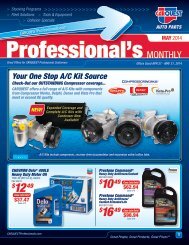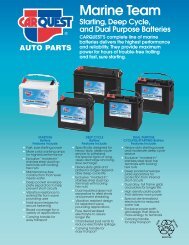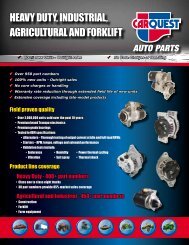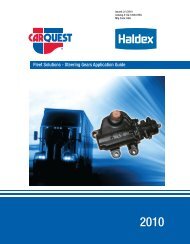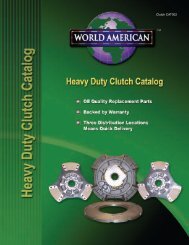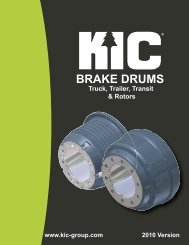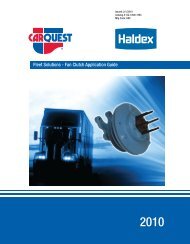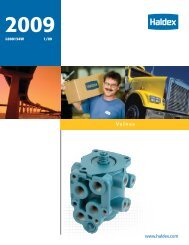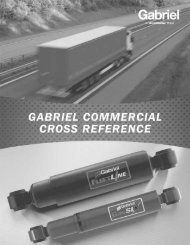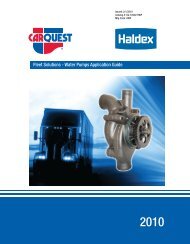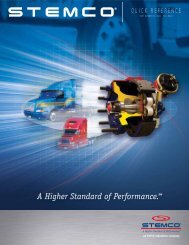- Page 1:
Issued / Publie // Emitido: January
- Page 4 and 5:
CARQUEST Filters Service Line1-800-
- Page 6 and 7:
Fuel Filter Locator ChartEngine Com
- Page 8 and 9:
ModelModel to Make Quick Reference
- Page 10 and 11:
ModelModel to Make Quick Reference
- Page 12 and 13:
ModelModel to Make Quick Reference
- Page 14 and 15:
Carbon Canister FiltersApplication
- Page 16 and 17:
Engine Conversion ChartPopular Engi
- Page 18 and 19:
MOTORCYCLESHARLEY-DAVIDSONMOTORCYCL
- Page 20 and 21:
MOTORCYCLESINDIANMOTORCYCLESMake &
- Page 22:
MOTORCYCLESVICTORYMOTORCYCLESMake &
- Page 25 and 26:
ATVSYAMAHAMake & Model Serv. Part N
- Page 27 and 28:
CARQUEST FiltersACURA 2013-2011Year
- Page 29 and 30:
CARQUEST FiltersACURA 2007-2005Year
- Page 31 and 32:
CARQUEST FiltersACURA 2002-1999Year
- Page 33 and 34:
CARQUEST FiltersACURA 1996-1992Year
- Page 35 and 36:
CARQUEST FiltersAUDI 2013YearModel/
- Page 37 and 38:
CARQUEST FiltersAUDI 2011-2010YearM
- Page 39 and 40:
CARQUEST FiltersAUDI 2009-2007YearM
- Page 41 and 42:
CARQUEST FiltersAUDI 2006-2004YearM
- Page 43 and 44:
CARQUEST FiltersAUDI 2003-2001YearM
- Page 45 and 46:
CARQUEST FiltersAUDI 1999-1995YearM
- Page 47 and 48:
CARQUEST FiltersAUDI 1991 — BMW 2
- Page 49 and 50:
CARQUEST FiltersBMW 2012-2011YearMo
- Page 51 and 52:
CARQUEST FiltersBMW 2010-2009YearMo
- Page 53 and 54:
CARQUEST FiltersBMW 2007-2006YearMo
- Page 55 and 56:
CARQUEST FiltersBMW 2004-2003YearMo
- Page 57 and 58:
CARQUEST FiltersBMW 2001-1999YearMo
- Page 59 and 60:
CARQUEST FiltersBMW 1997-1994YearMo
- Page 61 and 62:
CARQUEST FiltersBMW 1992 — BUICK
- Page 63 and 64:
CARQUEST FiltersBUICK 2009-2007Year
- Page 65 and 66:
CARQUEST FiltersBUICK 2004-2000Year
- Page 67 and 68:
CARQUEST FiltersBUICK 1996-1994Year
- Page 69 and 70:
CARQUEST FiltersBUICK 1992 — CADI
- Page 71 and 72:
CARQUEST FiltersCADILLAC 2010-2007Y
- Page 73 and 74:
CARQUEST FiltersCADILLAC 2005-2001Y
- Page 75 and 76:
CARQUEST FiltersCADILLAC 1997-1993Y
- Page 77 and 78:
CARQUEST FiltersCHEVROLET 2013YearM
- Page 79 and 80:
CARQUEST FiltersCHEVROLET 2012-2011
- Page 81 and 82:
CARQUEST FiltersCHEVROLET 2011-2010
- Page 83 and 84:
CARQUEST FiltersCHEVROLET 2009-2008
- Page 85 and 86:
CARQUEST FiltersCHEVROLET 2008-2007
- Page 87 and 88:
CARQUEST FiltersCHEVROLET 2007-2006
- Page 89 and 90:
CARQUEST FiltersCHEVROLET 2005YearM
- Page 91 and 92:
CARQUEST FiltersCHEVROLET 2004YearM
- Page 93 and 94:
CARQUEST FiltersCHEVROLET 2003YearM
- Page 95 and 96:
CARQUEST FiltersCHEVROLET 2002-2001
- Page 97 and 98:
CARQUEST FiltersCHEVROLET 2001-2000
- Page 99 and 100:
CARQUEST FiltersCHEVROLET 1999YearM
- Page 101 and 102:
CARQUEST FiltersCHEVROLET 1998YearM
- Page 103 and 104:
CARQUEST FiltersCHEVROLET 1997-1996
- Page 105 and 106:
CARQUEST FiltersCHEVROLET 1996-1995
- Page 107 and 108:
CARQUEST FiltersCHEVROLET 1995-1994
- Page 109 and 110:
CARQUEST FiltersCHEVROLET 1993YearM
- Page 111 and 112:
CARQUEST FiltersCHEVROLET 1992YearM
- Page 113 and 114:
CARQUEST FiltersCHEVROLET 1992-1991
- Page 115 and 116:
CARQUEST FiltersCHEVROLET 1991 —
- Page 117 and 118:
CARQUEST FiltersCHRYSLER 2009-2007Y
- Page 119 and 120:
CARQUEST FiltersCHRYSLER 2005-2003Y
- Page 121 and 122:
CARQUEST FiltersCHRYSLER 2001-2000Y
- Page 123 and 124:
CARQUEST FiltersCHRYSLER 1998-1996Y
- Page 125 and 126:
CARQUEST FiltersCHRYSLER 1993-1991Y
- Page 127 and 128:
CARQUEST FiltersDAIHATSU 1992 — D
- Page 129 and 130:
CARQUEST FiltersDODGE 2010-2009Year
- Page 131 and 132:
CARQUEST FiltersDODGE 2008-2007Year
- Page 133 and 134:
CARQUEST FiltersDODGE 2006-2005Year
- Page 135 and 136:
CARQUEST FiltersDODGE 2003-2002Year
- Page 137 and 138:
CARQUEST FiltersDODGE 2001-2000Year
- Page 139 and 140:
CARQUEST FiltersDODGE 1999-1998Year
- Page 141 and 142:
CARQUEST FiltersDODGE 1997-1996Year
- Page 143 and 144:
CARQUEST FiltersDODGE 1995-1994Year
- Page 145 and 146:
CARQUEST FiltersDODGE 1993-1992Year
- Page 147 and 148:
CARQUEST FiltersDODGE 1992-1991Year
- Page 149 and 150:
CARQUEST FiltersEAGLE 1996-1993Year
- Page 151 and 152:
CARQUEST FiltersFERRARI 1998 — FO
- Page 153 and 154:
CARQUEST FiltersFORD 2012YearModel/
- Page 155 and 156:
CARQUEST FiltersFORD 2011-2010YearM
- Page 157 and 158:
CARQUEST FiltersFORD 2009-2008YearM
- Page 159 and 160:
CARQUEST FiltersFORD 2007YearModel/
- Page 161 and 162:
CARQUEST FiltersFORD 2006-2005YearM
- Page 163 and 164:
CARQUEST FiltersFORD 2004YearModel/
- Page 165 and 166:
CARQUEST FiltersFORD 2003YearModel/
- Page 167 and 168:
CARQUEST FiltersFORD 2002-2001YearM
- Page 169 and 170:
CARQUEST FiltersFORD 2001-2000YearM
- Page 171 and 172:
CARQUEST FiltersFORD 1999YearModel/
- Page 173 and 174:
CARQUEST FiltersFORD 1998-1997YearM
- Page 175 and 176:
CARQUEST FiltersFORD 1996YearModel/
- Page 177 and 178:
CARQUEST FiltersFORD 1995-1994YearM
- Page 179 and 180:
CARQUEST FiltersFORD 1994-1993YearM
- Page 181 and 182:
CARQUEST FiltersFORD 1992-1991YearM
- Page 183 and 184:
CARQUEST FiltersFORD 1991 — GEO 1
- Page 185 and 186:
CARQUEST FiltersGMC 2013-2012YearMo
- Page 187 and 188:
CARQUEST FiltersGMC 2011-2009YearMo
- Page 189 and 190:
CARQUEST FiltersGMC 2008-2007YearMo
- Page 191 and 192:
CARQUEST FiltersGMC 2006-2005YearMo
- Page 193 and 194:
CARQUEST FiltersGMC 2004-2003YearMo
- Page 195 and 196:
CARQUEST FiltersGMC 2002-2001YearMo
- Page 197 and 198:
CARQUEST FiltersGMC 2000-1999YearMo
- Page 199 and 200:
CARQUEST FiltersGMC 1998-1997YearMo
- Page 201 and 202:
CARQUEST FiltersGMC 1996-1995YearMo
- Page 203 and 204:
CARQUEST FiltersGMC 1995-1994YearMo
- Page 205 and 206:
CARQUEST FiltersGMC 1993-1992YearMo
- Page 207 and 208:
CARQUEST FiltersGMC 1992-1991YearMo
- Page 209 and 210:
CARQUEST FiltersHONDA 2013-2011Year
- Page 211 and 212:
CARQUEST FiltersHONDA 2009-2007Year
- Page 213 and 214:
CARQUEST FiltersHONDA 2005-2003Year
- Page 215 and 216:
CARQUEST FiltersHONDA 2000-1998Year
- Page 217 and 218:
CARQUEST FiltersHONDA 1994 — HUMM
- Page 219 and 220:
CARQUEST FiltersHUMMER 1996 — HYU
- Page 221 and 222:
CARQUEST FiltersHYUNDAI 2011-2009Ye
- Page 223 and 224:
CARQUEST FiltersHYUNDAI 2008-2006Ye
- Page 225 and 226:
CARQUEST FiltersHYUNDAI 2001-1996Ye
- Page 227 and 228:
CARQUEST FiltersHYUNDAI 1992 — IN
- Page 229 and 230:
CARQUEST FiltersINFINITI 2009-2006Y
- Page 231 and 232:
CARQUEST FiltersINFINITI 2001-1996Y
- Page 233 and 234:
CARQUEST FiltersISUZU 2005-1999Year
- Page 235 and 236:
CARQUEST FiltersISUZU 1995-1992Year
- Page 237 and 238:
CARQUEST FiltersJAGUAR 2011-2008Yea
- Page 239 and 240:
CARQUEST FiltersJAGUAR 2005-2003Yea
- Page 241 and 242:
CARQUEST FiltersJAGUAR 2000-1993Yea
- Page 243 and 244:
CARQUEST FiltersJEEP 2010-2008YearM
- Page 245 and 246:
CARQUEST FiltersJEEP 2005-2002YearM
- Page 247 and 248:
CARQUEST FiltersJEEP 1997-1994YearM
- Page 249 and 250:
CARQUEST FiltersKIA 2013-2011YearMo
- Page 251 and 252:
CARQUEST FiltersKIA 2010-2008YearMo
- Page 253 and 254:
CARQUEST FiltersKIA 2006-2004YearMo
- Page 255 and 256:
CARQUEST FiltersKIA 2001 — LADA 1
- Page 257 and 258:
CARQUEST FiltersLAND ROVER 2007-200
- Page 259 and 260:
CARQUEST FiltersLAND ROVER 1995 —
- Page 261 and 262:
CARQUEST FiltersLEXUS 2011-2010Year
- Page 263 and 264:
CARQUEST FiltersLEXUS 2009-2008Year
- Page 265 and 266:
CARQUEST FiltersLEXUS 2006-2003Year
- Page 267 and 268:
CARQUEST FiltersLEXUS 1999-1997Year
- Page 269 and 270:
CARQUEST FiltersLEXUS 1992 — LINC
- Page 271 and 272:
CARQUEST FiltersLINCOLN 2006-2002Ye
- Page 273 and 274:
CARQUEST FiltersLINCOLN 1994 — MA
- Page 275 and 276:
CARQUEST FiltersMAZDA 2011-2009Year
- Page 277 and 278:
CARQUEST FiltersMAZDA 2008-2006Year
- Page 279 and 280:
CARQUEST FiltersMAZDA 2004-2002Year
- Page 281 and 282:
CARQUEST FiltersMAZDA 2000-1998Year
- Page 283 and 284:
CARQUEST FiltersMAZDA 1996-1995Year
- Page 285 and 286:
CARQUEST FiltersMAZDA 1993-1992Year
- Page 287 and 288:
CARQUEST FiltersMERCEDES BENZ 2013-
- Page 289 and 290:
CARQUEST FiltersMERCEDES BENZ 2011-
- Page 291 and 292:
CARQUEST FiltersMERCEDES BENZ 2009-
- Page 293 and 294:
CARQUEST FiltersMERCEDES BENZ 2007-
- Page 295 and 296:
CARQUEST FiltersMERCEDES BENZ 2005-
- Page 297 and 298:
CARQUEST FiltersMERCEDES BENZ 2003-
- Page 299 and 300:
CARQUEST FiltersMERCEDES BENZ 2001-
- Page 301 and 302:
CARQUEST FiltersMERCEDES BENZ 1999-
- Page 303 and 304:
CARQUEST FiltersMERCEDES BENZ 1995-
- Page 305 and 306:
CARQUEST FiltersMERCEDES BENZ 1991
- Page 307 and 308:
CARQUEST FiltersMERCURY 2008-2006Ye
- Page 309 and 310:
CARQUEST FiltersMERCURY 2003-2000Ye
- Page 311 and 312:
CARQUEST FiltersMERCURY 1997-1994Ye
- Page 313 and 314:
CARQUEST FiltersMERCURY 1991 — MI
- Page 315 and 316:
CARQUEST FiltersMINI 2008-2003YearM
- Page 317 and 318:
CARQUEST FiltersMITSUBISHI 2011-201
- Page 319 and 320:
CARQUEST FiltersMITSUBISHI 2007-200
- Page 321 and 322:
CARQUEST FiltersMITSUBISHI 2003-200
- Page 323 and 324:
CARQUEST FiltersMITSUBISHI 1998-199
- Page 325 and 326:
CARQUEST FiltersMITSUBISHI 1994-199
- Page 327 and 328:
CARQUEST FiltersNISSAN 2013-2012Yea
- Page 329 and 330:
CARQUEST FiltersNISSAN 2011-2010Yea
- Page 331 and 332:
CARQUEST FiltersNISSAN 2008-2007Yea
- Page 333 and 334:
CARQUEST FiltersNISSAN 2004-2003Yea
- Page 335 and 336:
CARQUEST FiltersNISSAN 1999-1997Yea
- Page 337 and 338:
CARQUEST FiltersNISSAN 1995-1993Yea
- Page 339 and 340:
CARQUEST FiltersNISSAN 1991 — OLD
- Page 341 and 342:
CARQUEST FiltersOLDSMOBILE 1997-199
- Page 343 and 344:
CARQUEST FiltersOLDSMOBILE 1992-199
- Page 345 and 346:
CARQUEST FiltersPLYMOUTH 1998-1995Y
- Page 347 and 348:
CARQUEST FiltersPLYMOUTH 1993-1992Y
- Page 349 and 350:
CARQUEST FiltersPONTIAC 2010-2008Ye
- Page 351 and 352:
CARQUEST FiltersPONTIAC 2006-2005Ye
- Page 353 and 354:
CARQUEST FiltersPONTIAC 2002-2000Ye
- Page 355 and 356:
CARQUEST FiltersPONTIAC 1997-1995Ye
- Page 357 and 358:
CARQUEST FiltersPONTIAC 1993-1991Ye
- Page 359 and 360:
CARQUEST FiltersPORSCHE 2012-2010Ye
- Page 361 and 362:
CARQUEST FiltersPORSCHE 2007-2003Ye
- Page 363 and 364:
CARQUEST FiltersPORSCHE 1996 — RA
- Page 365 and 366:
CARQUEST FiltersSAAB 2011-2006YearM
- Page 367 and 368:
CARQUEST FiltersSAAB 2001-1994YearM
- Page 369 and 370:
CARQUEST FiltersSATURN 2009-2007Yea
- Page 371 and 372:
CARQUEST FiltersSATURN 2004-1993Yea
- Page 373 and 374:
CARQUEST FiltersSCION 2009 — STER
- Page 375 and 376:
CARQUEST FiltersSUBARU 2011-2009Yea
- Page 377 and 378:
CARQUEST FiltersSUBARU 2006-2004Yea
- Page 379 and 380:
CARQUEST FiltersSUBARU 2000-1996Yea
- Page 381 and 382:
CARQUEST FiltersSUBARU 1991 — SUZ
- Page 383 and 384: CARQUEST FiltersSUZUKI 2005-2002Yea
- Page 385 and 386: CARQUEST FiltersSUZUKI 1997-1994Yea
- Page 387 and 388: CARQUEST FiltersTOYOTA 2013YearMode
- Page 389 and 390: CARQUEST FiltersTOYOTA 2012-2011Yea
- Page 391 and 392: CARQUEST FiltersTOYOTA 2010-2009Yea
- Page 393 and 394: CARQUEST FiltersTOYOTA 2007-2006Yea
- Page 395 and 396: CARQUEST FiltersTOYOTA 2005-2004Yea
- Page 397 and 398: CARQUEST FiltersTOYOTA 2003-2002Yea
- Page 399 and 400: CARQUEST FiltersTOYOTA 2001-2000Yea
- Page 401 and 402: CARQUEST FiltersTOYOTA 1998-1997Yea
- Page 403 and 404: CARQUEST FiltersTOYOTA 1996-1995Yea
- Page 405 and 406: CARQUEST FiltersTOYOTA 1994-1993Yea
- Page 407 and 408: CARQUEST FiltersTOYOTA 1991 — VOL
- Page 409 and 410: CARQUEST FiltersVOLKSWAGEN 2012-201
- Page 411 and 412: CARQUEST FiltersVOLKSWAGEN 2009-200
- Page 413 and 414: CARQUEST FiltersVOLKSWAGEN 2006-200
- Page 415 and 416: CARQUEST FiltersVOLKSWAGEN 2003-200
- Page 417 and 418: CARQUEST FiltersVOLKSWAGEN 2000-199
- Page 419 and 420: CARQUEST FiltersVOLKSWAGEN 1996-199
- Page 421 and 422: CARQUEST FiltersVOLKSWAGEN 1993 —
- Page 423 and 424: CARQUEST FiltersVOLVO 2010-2008Year
- Page 425 and 426: CARQUEST FiltersVOLVO 2007-2005Year
- Page 427 and 428: CARQUEST FiltersVOLVO 2004-2002Year
- Page 429 and 430: CARQUEST FiltersVOLVO 2000-1998Year
- Page 431 and 432: CARQUEST FiltersVOLVO 1992 — YUGO
- Page 433: Decimal and Metric EquivalentsDECIM
- Page 437 and 438: Technical Service Bulletin 83-2R2__
- Page 439 and 440: 437
- Page 441 and 442: 439
- Page 443 and 444: Moisture Ruins Compressed Air Equip



